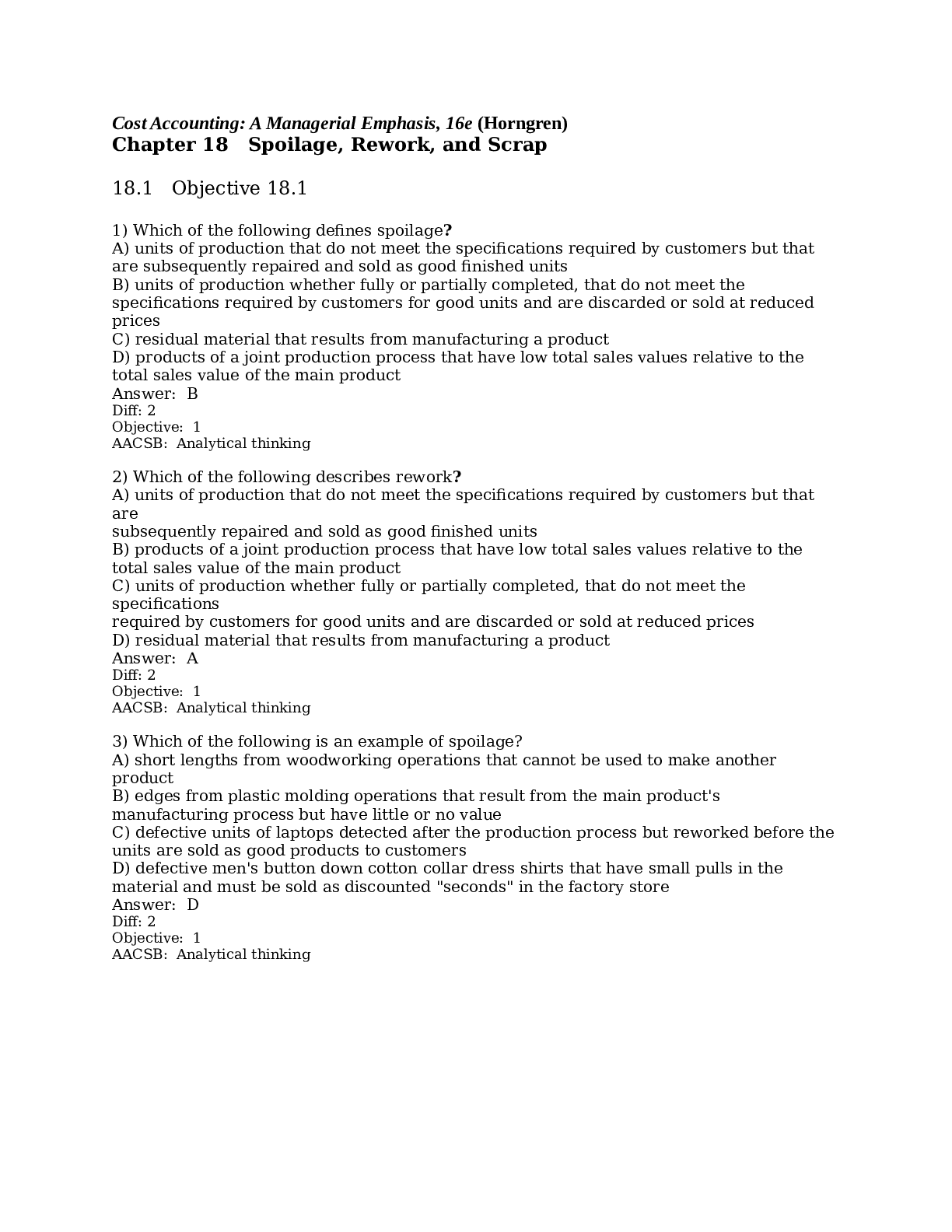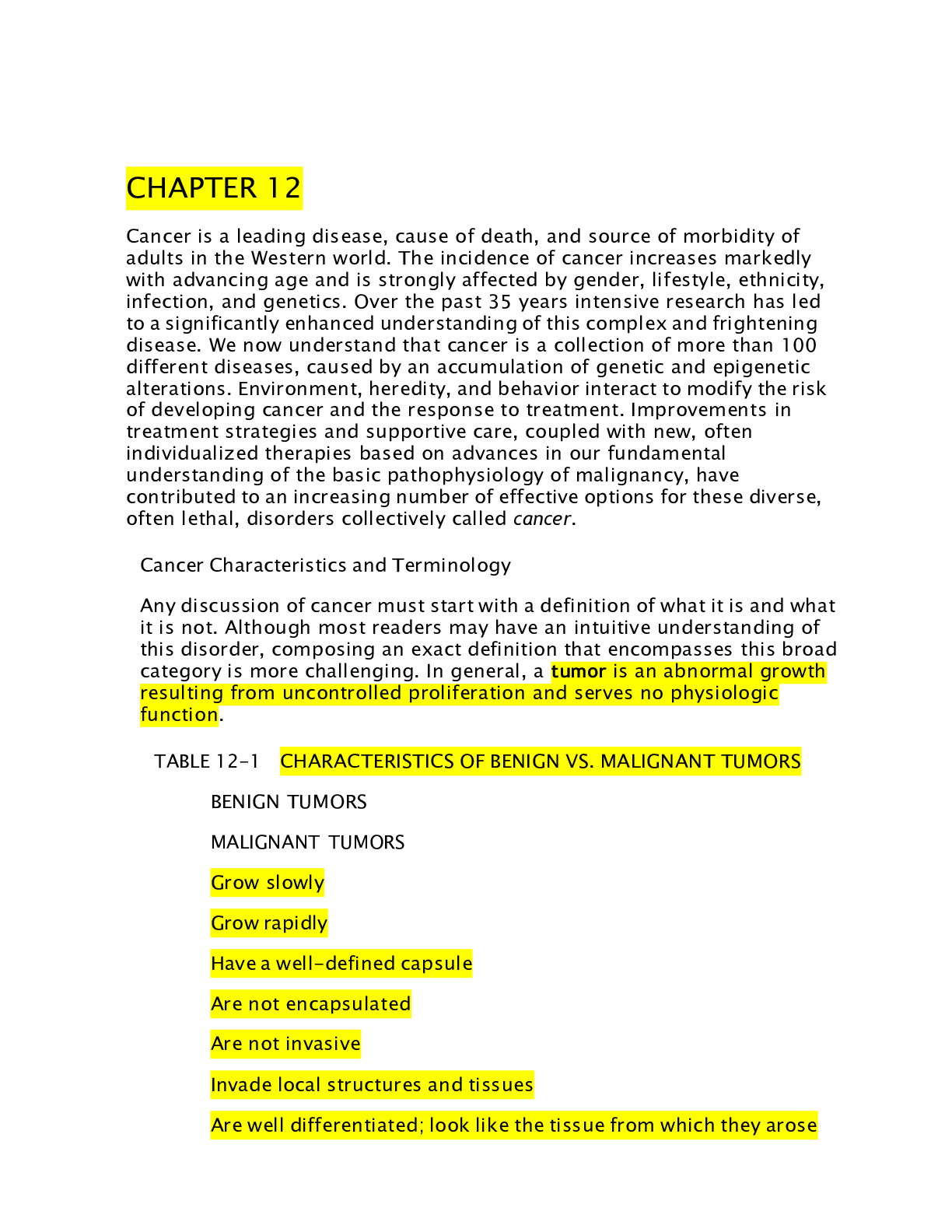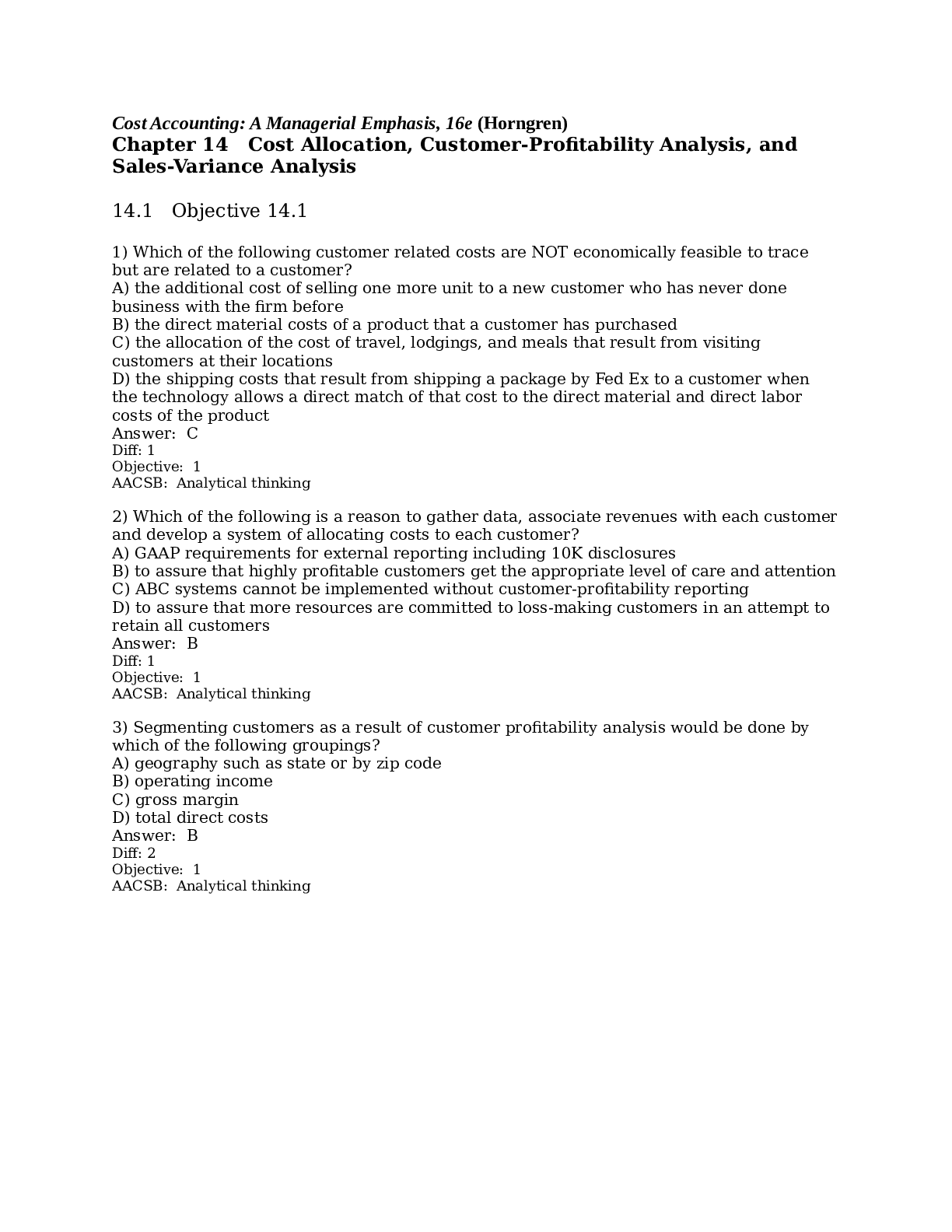Accounting > QUESTIONS & ANSWERS > ACCT 3201 Cost Accounting: A Managerial Emphasis, 16e (Horngren) Chapter 18 Spoilage, Rework, and Sc (All)
ACCT 3201 Cost Accounting: A Managerial Emphasis, 16e (Horngren) Chapter 18 Spoilage, Rework, and Scrap
Document Content and Description Below
1) Which of the following defines spoilage? A) units of production that do not meet the specifications required by customers but that are subsequently repaired and sold as good finished units B) un... its of production whether fully or partially completed, that do not meet the specifications required by customers for good units and are discarded or sold at reduced prices C) residual material that results from manufacturing a product D) products of a joint production process that have low total sales values relative to the total sales value of the main product Answer: B Diff: 2 Objective: 1 AACSB: Analytical thinking 2) Which of the following describes rework? A) units of production that do not meet the specifications required by customers but that are subsequently repaired and sold as good finished units B) products of a joint production process that have low total sales values relative to the total sales value of the main product C) units of production whether fully or partially completed, that do not meet the specifications required by customers for good units and are discarded or sold at reduced prices D) residual material that results from manufacturing a product Answer: A Diff: 2 Objective: 1 AACSB: Analytical thinking 3) Which of the following is an example of spoilage? A) short lengths from woodworking operations that cannot be used to make another product B) edges from plastic molding operations that result from the main product's manufacturing process but have little or no value C) defective units of laptops detected after the production process but reworked before the units are sold as good products to customers D) defective men's button down cotton collar dress shirts that have small pulls in the material and must be sold as discounted "seconds" in the factory store Answer: D Diff: 2 Objective: 1 AACSB: Analytical thinking4) Which of the following best describes scrap? A) units of production that do not meet the specifications required by customers but that are subsequently repaired and sold as good finished units B) products of a joint production process that have low total sales values relative to the total sales value of the main product C) residual material that results from manufacturing a product D) units of production whether fully or partially completed, that do not meet the specifications required by customers for good units and are discarded or sold at reduced prices Answer: C Diff: 2 Objective: 1 AACSB: Analytical thinking 5) A leather shoe manufacturer makes "duck" boots that consist of leather and rubber. Some of the books are defective and are sold in the factory store at deep discounts. Leather strips from the cutting process and rubber shavings are byproducts of the process. The leather strips have no use and are discarded while the rubber scraps are collected and periodically picked up by a recycling company at no cost to the shoe manufacturer. Which of the following classifications of these items would be accurate? A) the defective boots are spoilage and the leather and the rubber are scrap B) the defective boots, leather and rubber are scrap but the shoes are more valuable scrap as they can be sold C) the defective boots are spoilage , the leather strips are scrap, and the rubber is rework D) all three items are spoilage Answer: A Diff: 2 Objective: 1 AACSB: Analytical thinking 6) Which of the following is an example of scrap? A) short lengths from woodworking operations that must be discarded B) defective units of laptops detected after the production process but reworked before the units are sold as good products to customers C) defective aluminum cans sold to aluminum manufacturers for remelting to produce other aluminum products D) defective shirts, jeans, shoes, and carpeting sold as seconds Answer: A Diff: 2 Objective: 1 AACSB: Analytical thinking 7) Some amounts of spoilage, rework, or scrap are inherent in many production processes. Answer: TRUE Diff: 2 Objective: 1 AACSB: Analytical thinking8) An item classified as spoilage has no value. Answer: FALSE Explanation: Although the item does not meet the specifications, it may be sold as a "second" or for its scrap value. It is not necessarily thrown out. Diff: 2 Objective: 1 AACSB: Analytical thinking 9) Reworked goods are unacceptable units of production usually NOT capable of being repaired or converted into a salable product. Answer: FALSE Explanation: Rework is units of production that do not meet the specifications required by customers but that are subsequently repaired and sold as good finished units. Diff: 2 Objective: 1 AACSB: Analytical thinking 10) Rework is finished production that is NOT in accordance with customer desires. The product is redone and sold as finished goods. Answer: TRUE Diff: 2 Objective: 1 AACSB: Analytical thinking 11) Rework is residual material that results from manufacturing a product and can have either a high or low sales value relative to the product with which it is associated. Answer: FALSE Explanation: Scrap is residual material that results from manufacturing a product. Examples are short lengths from woodworking operations, edges from plastic molding operations, and frayed cloth and end cuts from suit-making operations. Scrap can sometimes be sold for relatively small amounts. Diff: 2 Objective: 1 AACSB: Analytical thinking 12) Scrap and rework are considered to be the same thing by managerial accountants. Answer: FALSE Explanation: Scrap and rework are not considered to be the same thing by managerial accountants. Diff: 2 Objective: 1 AACSB: Analytical thinking 13) There is no difference between scrap which can be sold for relatively small amount and a byproduct. Answer: FALSE Explanation: The difference is that scrap arises as a residual from the manufacturing process and is not a product targeted for manufacture or sale by the firm. Diff: 2 Objective: 1 AACSB: Analytical thinking14) Distinguish among spoilage, reworked units, and scrap. Give an example of each. Answer: Spoilage refers to unacceptable units of production that are discarded or are sold for reduced prices. Both partially completed or fully completed units of output can be spoiled. Examples are defective clothes sold as seconds. Reworked units are unacceptable units of production that are subsequently repaired and sold as acceptable finished goods. Defective units of product (such as pagers, computer disk drives, computers, and telephones) detected during production or immediately after production but before units are shipped to customers, can sometimes be reworked and sold as good products. Scrap is material left over when making a product. It has low sales value compared with the sales value of the product. Examples are shavings and short lengths from woodworking operations and edges left over from plastic molding operations. Diff: 2 Objective: 1 AACSB: Analytical thinking 15) For each of the following items id [Show More]
Last updated: 2 years ago
Preview 1 out of 71 pages

Buy this document to get the full access instantly
Instant Download Access after purchase
Buy NowInstant download
We Accept:

Reviews( 0 )
$13.00
Can't find what you want? Try our AI powered Search
Document information
Connected school, study & course
About the document
Uploaded On
Jul 09, 2021
Number of pages
71
Written in
Additional information
This document has been written for:
Uploaded
Jul 09, 2021
Downloads
0
Views
95








.png)

.png)






